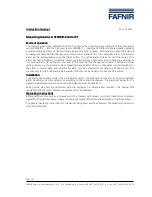
DW1000 User Manual
© Decawave Ltd 2017
Version 2.12
Page 44 of 242
NOTE: In the
state the 125 MHz digital PLL clock is not running, instead the system is clocked at the raw
19.2 MHz XTI clock rate. Thus, in Low duty-cycle SNIFF mode the off period configured in the SNIFF_OFFT is
in multiples of 6.6 µs (instead of the 1 µs units that apply in the SNIFF mode).
The power saving of Low duty-cycle SNIFF mode is only realised when the off period is greater than 1 (i.e. >
6.6 µs). This is because after the timer expiry the DW1000 will enter the
and locks (this takes approximately 5 µs) before progressing into the
Figure 21 shows the power profile associated with Low duty-cycle SNIFF mode where the IC wakes up from
and progress into the repeated
cycles of the pulsed preamble detection
mode. A timeout ends this and the DW1000 is returned to
Figure 21: Power profile for Low duty-cycle SNIFF where a frame is not received
4.6 Diagnostics
The DW1000 includes the following diagnostic aids: -
The ability to drive LEDs to show TX and RX activity, which may be useful during product
development and in non-battery powered devices. The LED driving feature is an option on GPIO
lines, and is configurable via
Sub-Register 0x26:00 – GPIO_MODE
. Please refer to the register
description for details of the supported functionality.
Access to accumulator – of use during product development diagnostics. This is provided via
memory. Please refer to its description for details.
RX frame quality indications – of use for both product development diagnostics and for working
diagnostics, e.g. for network management or for deciding on confidence level for an RTLS or ranging
measurement. These are available through
Register file: 0x12 – Rx Frame Quality Information
Please refer to its description for details, and to section
4.7 – Assessing the quality of reception and
4.7 Assessing the quality of reception and the RX timestamp
The DW1000 receiver is capable of receiving messages under many different conditions. In some
circumstances it can be useful to assess the quality of the received signals and any timestamp data based on
them.
RX
IDLE
INIT
GO2SLP
Sample Wakeup Event:
Sleep counter expires
SLEEP
SLEEP
Frame Wait Timeout,
Host RX End.
WAKEUP
CLKPLL locked
Cryst al stable,
RSTn=1
RX
Configure RX Sniff Mode
Sniff On Time
(in PACs)
Sniff Of f Time
(in 19.2MHz cycles)
INIT
IDLE
INIT
RX
IDLE
PLL Lock
Time (~5uS)
INIT
IDLE
















































